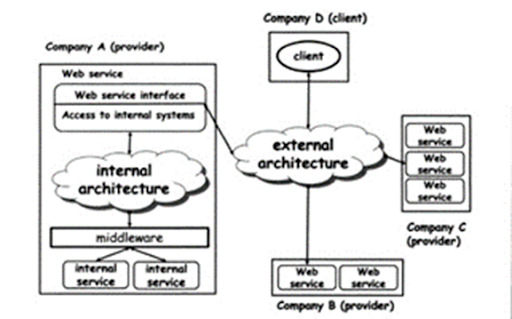
The Architecture of Custom Web Development Services
Web services are a type of distributed information system that exposes its functionality and makes it available through standard web technologies.
Web services are a type of distributed information system that exposes its functionality and makes it available through standard web technologies. The true definition of web services is very complicated. It ranges from very general to very specific. The most accurate definition is provided by the World Wide Web Consortium. “A Web service is a software system designed to support interoperable machine-to-machine interaction over a network. It has an interface described in a machine-processable format (specifically WSDL). Other systems interact with the Web service in a manner prescribed by its description using SOAP messages, typically conveyed using HTTP with an XML serialization in conjunction with other Web-related standards.” It is available in two forms: custom and non-custom services. Our topic of concern is custom web development services which are crucial for the maintenance of websites and their applications. They are based upon a system of external and internal architectures that are further composed of many exclusive components. To have a clear understanding of how a custom web service works, a complete understanding of its external and internal architecture is essential. Let’s discuss them one by one:
Internal Architecture
The internal architecture is comprised of behind-the-scenes components that handle the core functionalities, data processing, and business logic of web application development services.
Components:
Its components are divided into three layers:
-
Presentation Layer: It consists of HTML, CSS, JavaScript, and frameworks like React and Angular. It regulates the user interface and user experience. It also manages the interaction between the user and the application. Responsiveness and accessibility are key considerations for this layer.
-
Application Layer: It consists of Python, Java, Node, and frameworks like Spring and Express. It processes the request coming from the presentation layer. It regulates the processes of authorization and authentication. The maintainability and security of the service are primary concerns for this layer.
-
Data Layer: Its components include databases like MySQL and MongoDB. It is responsible for data storage and management. It connects with the application layer for the processing of user requests. Backup and recovery mechanisms are key considerations for this layer.

External Architecture
It refers to the components and services that connect with the web application from outside of the internal architecture. These components assist in the incorporation and distribution of web applications.
Key Aspects:
It includes the following key aspects:
-
Client-Side Interaction: It includes mobile devices and web browsers. It involves the interaction between the user and the application. The users access the application through different interfaces that connect with the internal architecture via the internet. The responsiveness and compatibility of the user are key considerations for this interaction.
-
Third-Party Services: It includes external APIs and cloud services. It also involves additional features that are integrated into the web application—for example, cloud storage and external data sources. Security and proper collaboration are key considerations for these services.
-
Content Delivery Network (CDN): It includes components such as Cloudflare and Amazon CloudFront. It distributes the web content across multiple networks globally to provide reliable access for users. Availability and reduced deferment are key considerations for this network.
-
Load Balancers and Reverse Proxies: It includes components like HAProxy and Nginx. It distributes the incoming traffic across multiple networks to reduce load on the server and ensure maximum resource utilization.
-
Security Services: It includes components such as firewalls and DDoS protection services. It protects the application from any external threats and ensures data security. Implementation and maintenance of security standards are key considerations.
Integration between Internal and External Architecture
The integration between external and internal architecture is necessary for the cohesive function of a web application. It can be done by taking advantage of the following web development services and tools:
- Microservices: It increases the efficiency of the application by breaking down the application into smaller services.
- Web Services: It is also a way to facilitate the interaction between internal and external architecture.
- Software Tools: Many software tools have been used to regulate the performance of both types of components.
- Continuous Integration and Deployment (CI/CD): In this technique, the deployment process is automated to ensure a smooth, continuous workflow in case of any changes in the architecture.
Conclusion
A robust and efficient custom web development service can only be developed after a thorough understanding of both its external and internal architecture. The internal architecture deals with the core features, while the external architecture deals with content distribution and user interference. A smooth integration between these two architectures can help in creating a web service that aligns best with the user's demands. Please visit our website, Artema Tech, for more information.
